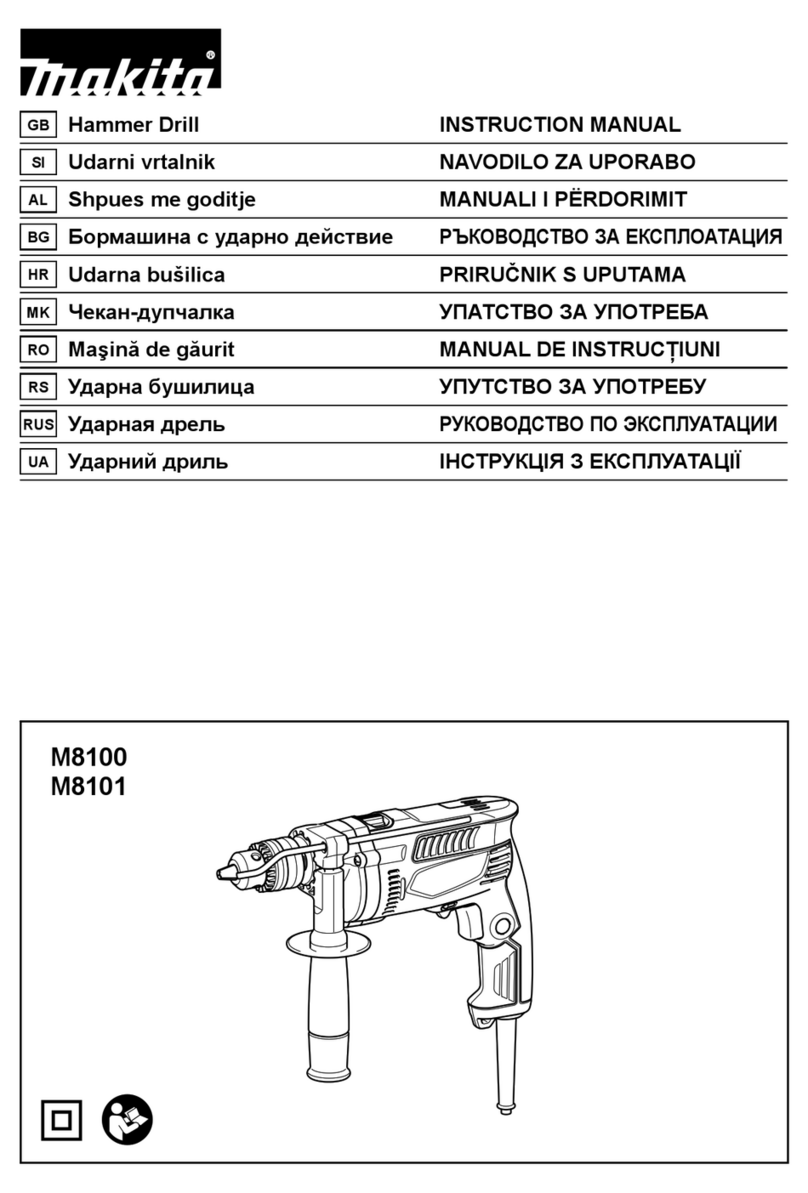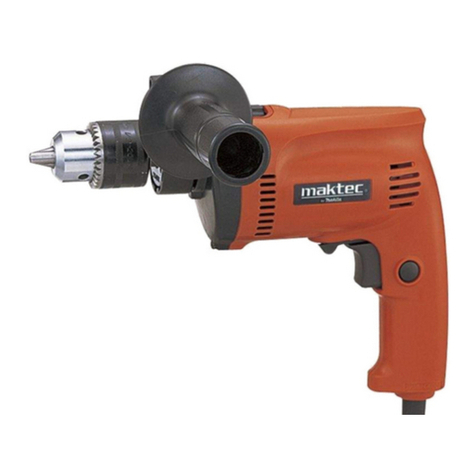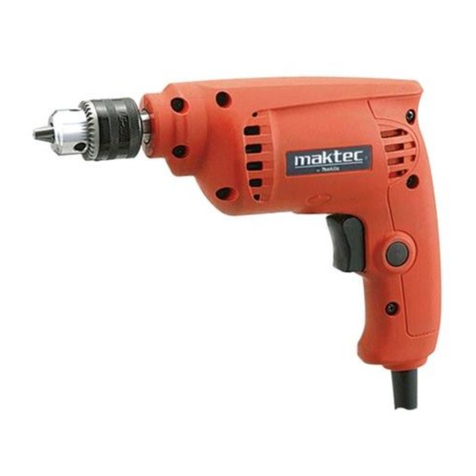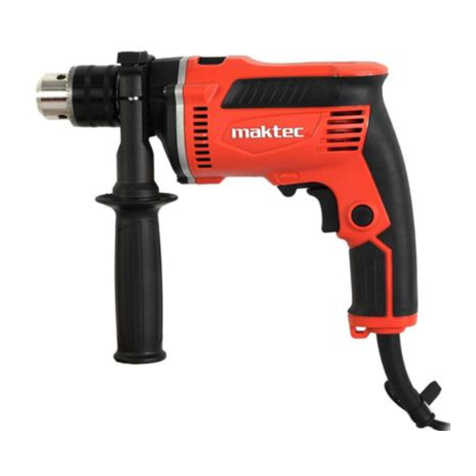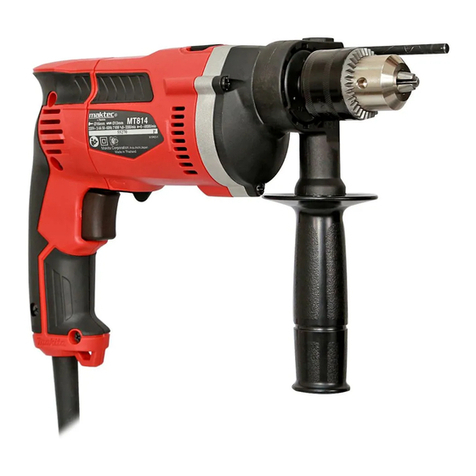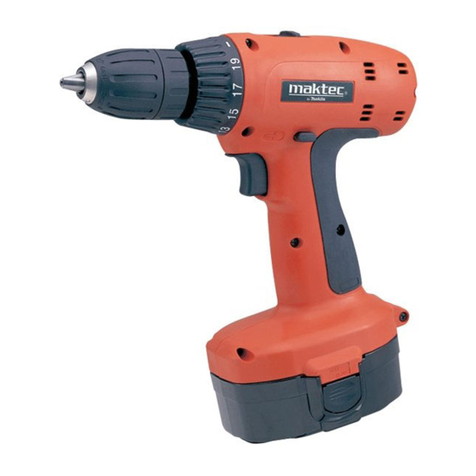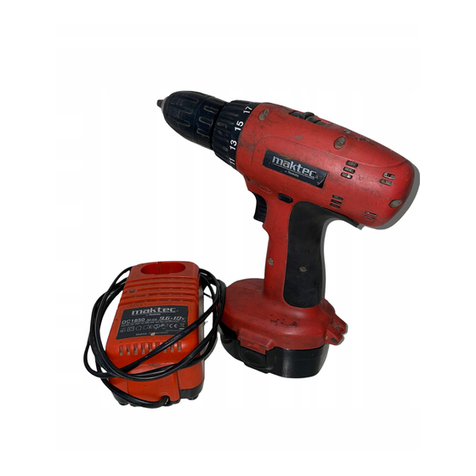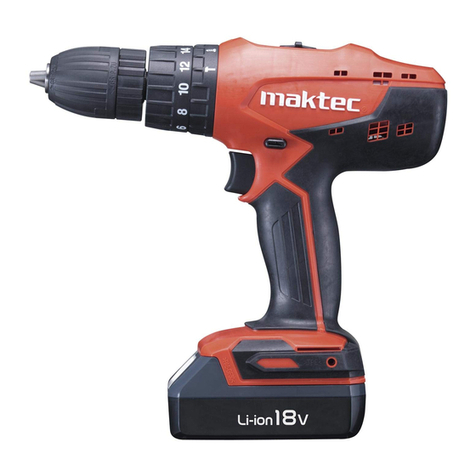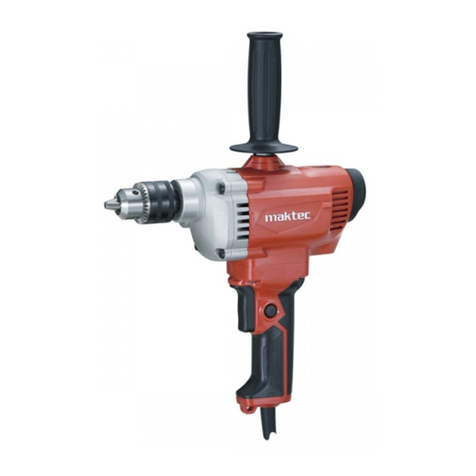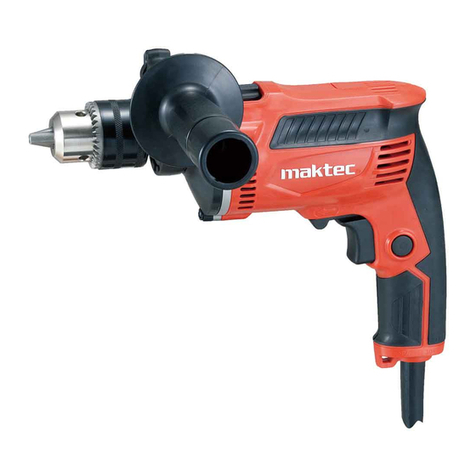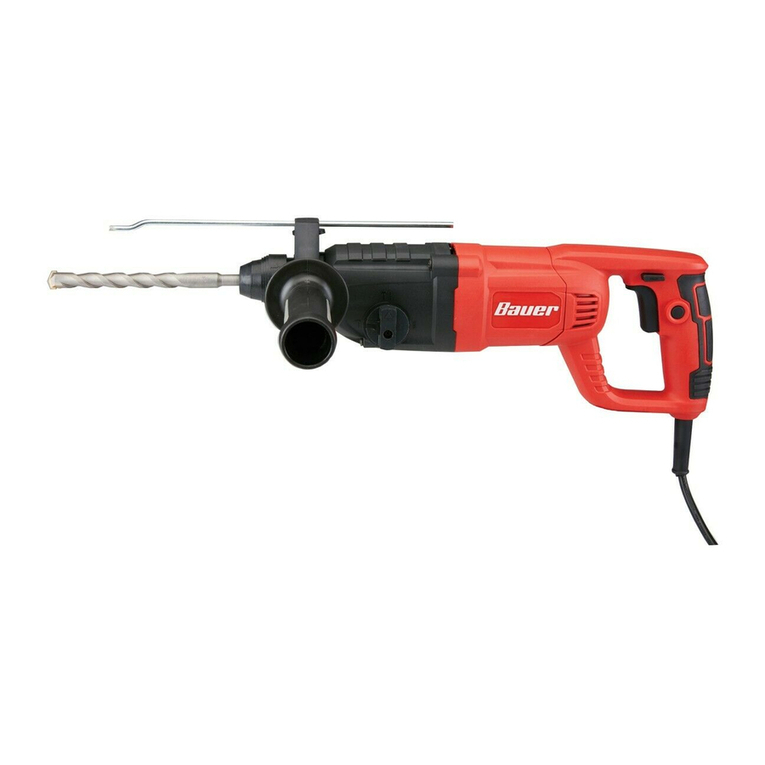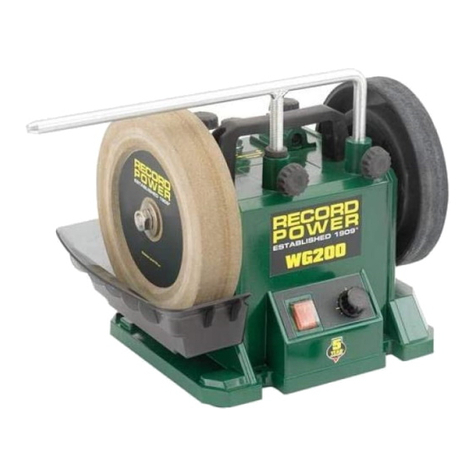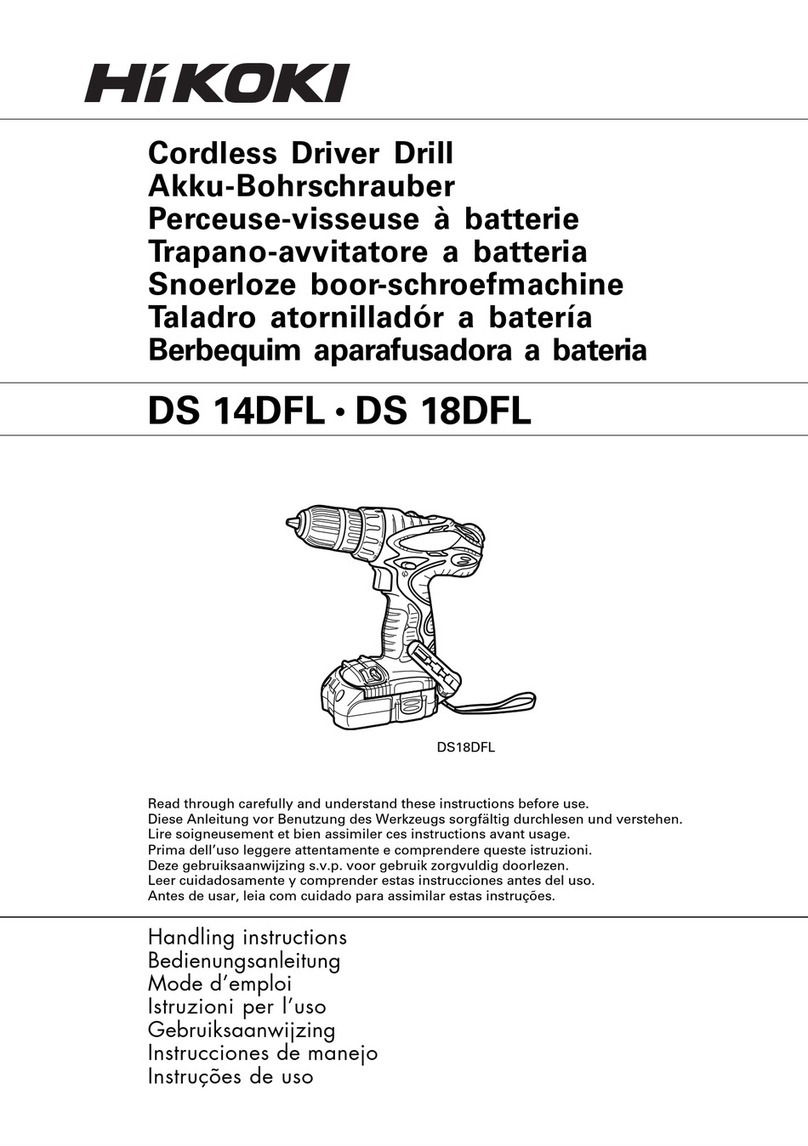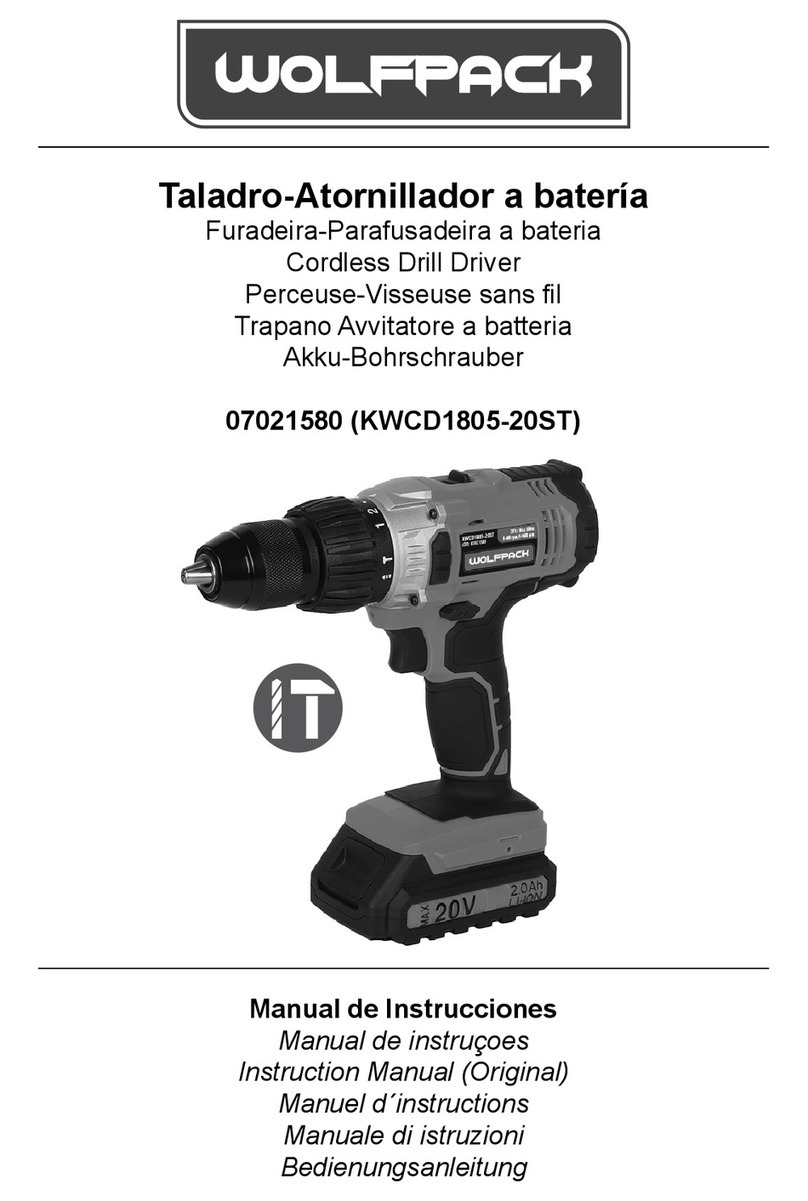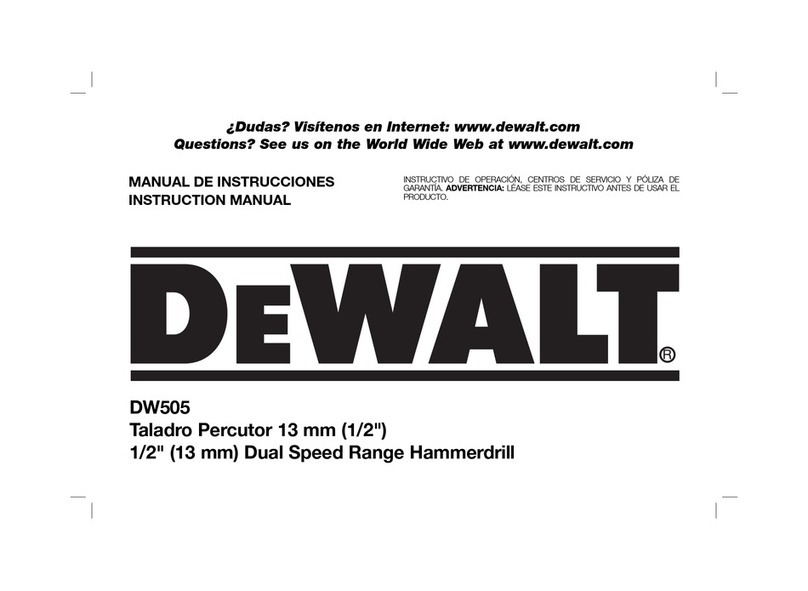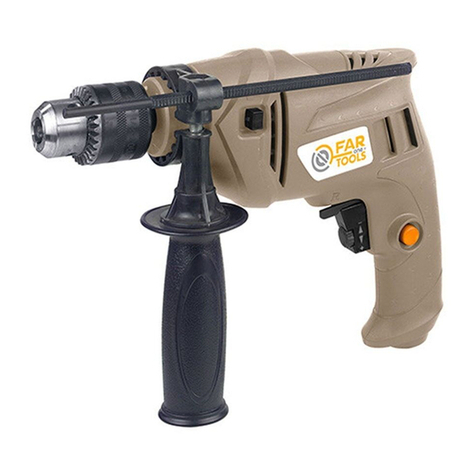Maktec MT80A User manual

Hammer Drill Instruction manual
Bor Palu Petunjuk penggunaan
Máy khoan búa Tài liệu hướng dẫn
สวานไฟฟาแบบเจาะกระแทก คูมือการใชงาน
MT80A
MT80B
GB
VI
TH
ID

2
1013746 2013747
3015033 4013749
5013750 6013751
7013752
1
2
A
B
3
4
6
5
7
910
8
11
12
13
14
5
1
5

3
ENGLISH
Explanation of general view
SPECIFICATIONS
• Due to our continuing program of research and development, the specifications herein are subject to change without
notice.
• Specifications may differ from country to country.
• Weight according to EPTA-Procedure 01/2003
END201-7
Symbols
The following show the symbols used for the equipment.
Be sure that you understand their meaning before use.
..... Read instruction manual.
.............. DOUBLE INSULATION
ENE039-1
Intended use
The tool is intended for impact drilling in brick, concrete
and stone as well as for drilling without impact in wood,
metal, ceramic and plastic.
ENF002-2
Power supply
The tool should be connected only to a power supply of
the same voltage as indicated on the nameplate, and can
only be operated on single-phase AC supply. They are
double-insulated and can, therefore, also be used from
sockets without earth wire.
GEA005-3
General Power Tool Safety
Warnings
WARNING Read all safety warnings and all
instructions. Failure to follow the warnings and
instructions may result in electric shock, fire and/or
serious injury.
Save all warnings and
instructions for future reference.
The term “power tool” in the warnings refers to your
mains-operated (corded) power tool or battery-operated
(cordless) power tool.
Work area safety
1. Keep work area clean and well lit. Cluttered or dark
areas invite accidents.
2. Do not operate power tools in explosive
atmospheres, such as in the presence of
flammable liquids, gases or dust. Power tools
create sparks which may ignite the dust or fumes.
3.
Keep children and bystanders away while operating
a power tool.
Distractions can cause you to lose control.
Electrical safety
4. Power tool plugs must match the outlet. Never
modify the plug in any way. Do not use any
adapter plugs with earthed (grounded) power
tools. Unmodified plugs and matching outlets will
reduce risk of electric shock.
5. Avoid body contact with earthed or grounded
surfaces such as pipes, radiators, ranges and
refrigerators. There is an increased risk of electric
shock if your body is earthed or grounded.
6. Do not expose power tools to rain or wet
conditions. Water entering a power tool will increase
the risk of electric shock.
7. Do not abuse the cord. Never use the cord for
carrying, pulling or unplugging the power tool.
Keep cord away from heat, oil, sharp edges or
moving parts. Damaged or entangled cords increase
the risk of electric shock.
1. Switch trigger
2. Lock button
3. Reversing switch lever
4. Action mode changing lever
5. Grip base
6. Teeth
7. Side grip (auxiliary handle)
8. Protrusion
9. Loosen
10. Tighten
11. Drill chuck
12. Chuck key
13. Side grip
14. Depth gauge
15. Hex bolt
Model MT80A MT80B
Capacities
Concrete 10 mm 16 mm
Wood 20 mm 20 mm
Steel 10 mm 13 mm
No load speed (min-1) 0 - 3,200 0 - 3,200
Blows per minute 0 - 48,000 0 - 48,000
Overall length 254 mm 262 mm
Net weight 1.6 kg 1.7 kg
Safety class /II

4
8. When operating a power tool outdoors, use an
extension cord suitable for outdoor use. Use of a
cord suitable for outdoor use reduces the risk of
electric shock.
9. If operating a power tool in a damp location is
unavoidable, use a residual current device (RCD)
protected supply. Use of an RCD reduces the risk of
electric shock.
10. Use of power supply via a RCD with a rated
residual current of 30mA or less is always
recommended.
Personal safety
11. Stay alert, watch what you are doing and use
common sense when operating a power tool. Do
not use a power tool while you are tired or under
the influence of drugs, alcohol or medication. A
moment of inattention while operating power tools
may result in serious personal injury.
12. Use personal protective equipment. Always wear
eye protection. Protective equipment such as dust
mask, non-skid safety shoes, hard hat, or hearing
protection used for appropriate conditions will reduce
personal injuries.
13. Prevent unintentional starting. Ensure the switch
is in the off-position before connecting to power
source and/or battery pack, picking up or carrying
the tool. Carrying power tools with your finger on the
switch or energising power tools that have the switch
on invites accidents.
14. Remove any adjusting key or wrench before
turning the power tool on. A wrench or a key left
attached to a rotating part of the power tool may result
in personal injury.
15. Do not overreach. Keep proper footing and
balance at all times. This enables better control of
the power tool in unexpected situations.
16. Dress properly. Do not wear loose clothing or
jewellery. Keep your hair, clothing, and gloves
away from moving parts. Loose clothes, jewellery or
long hair can be caught in moving parts.
17. If devices are provided for the connection of dust
extraction and collection facilities, ensure these
are connected and properly used. Use of dust
collection can reduce dust-related hazards.
Power tool use and care
18. Do not force the power tool. Use the correct power
tool for your application. The correct power tool will
do the job better and safer at the rate for which it was
designed.
19. Do not use the power tool if the switch does not
turn it on and off. Any power tool that cannot be
controlled with the switch is dangerous and must be
repaired.
20. Disconnect the plug from the power source and/or
the battery pack from the power tool before
making any adjustments, changing accessories,
or storing power tools. Such preventive safety
measures reduce the risk of starting the power tool
accidentally.
21. Store idle power tools out of the reach of children
and do not allow persons unfamiliar with the
power tool or these instructions to operate the
power tool. Power tools are dangerous in the hands
of untrained users.
22. Maintain power tools. Check for misalignment or
binding of moving parts, breakage of parts and
any other condition that may affect the power
tool’s operation. If damaged, have the power tool
repaired before use. Many accidents are caused by
poorly maintained power tools.
23. Keep cutting tools sharp and clean. Properly
maintained cutting tools with sharp cutting edges are
less likely to bind and are easier to control.
24. Use the power tool, accessories and tool bits etc.
in accordance with these instructions, taking into
account the working conditions and the work to
be performed. Use of the power tool for operations
different from those intended could result in a
hazardous situation.
Service
25. Have your power tool serviced by a qualified
repair person using only identical replacement
parts. This will ensure that the safety of the power tool
is maintained.
26. Follow instruction for lubricating and changing
accessories.
27. Keep handles dry, clean and free from oil and
grease.
GEB003-5
HAMMER DRILL SAFETY
WARNINGS
1. Wear ear protectors when impact drilling.
Exposure to noise can cause hearing loss.
2. Use auxiliary handle(s), if supplied with the tool.
Loss of control can cause personal injury.
3. Hold power tool by insulated gripping surfaces,
when performing an operation where the cutting
accessory may contact hidden wiring or its own
cord. Cutting accessory contacting a “live” wire may
make exposed metal parts of the power tool “live” and
could give the operator an electric shock.
4. Always be sure you have a firm footing.
Be sure no one is below when using the tool in
high locations.
5. Hold the tool firmly with both hands.
6. Keep hands away from rotating parts.
7. Do not leave the tool running. Operate the tool
only when hand-held.
8. Do not touch the bit or the workpiece immediately
after operation; they may be extremely hot and
could burn your skin.
9. Some material contains chemicals which may be
toxic. Take caution to prevent dust inhalation and
skin contact. Follow material supplier safety data.
SAVE THESE INSTRUCTIONS.
WARNING:
DO NOT let comfort or familiarity with product (gained
from repeated use) replace strict adherence to safety
rules for the subject product. MISUSE or failure to
follow the safety rules stated in this instruction
manual may cause serious personal injury.

5
FUNCTIONAL DESCRIPTION
Switch action (Fig. 1)
CAUTION:
• Before plugging in the tool, always check to see that
the switch trigger actuates properly and returns to the
“OFF” position when released.
• Switch can be locked in “ON” position for ease of
operator comfort during extended use. Apply caution
when locking tool in “ON” position and maintain firm
grasp on tool.
To start the tool, simply pull the switch trigger. Tool speed
is increased by increasing pressure on the switch trigger.
Release the switch trigger to stop. For continuous
operation, pull the switch trigger, push in the lock button
and then release the switch trigger. To stop the tool from
the locked position, pull the switch trigger fully, then
release it.
Reversing switch action (Fig. 2)
CAUTION:
• Always check the direction of rotation before operation.
• Use the reversing switch only after the tool comes to a
complete stop. Changing the direction of rotation
before the tool stops may damage the tool.
• If the switch trigger can not be depressed, check to see
that the reversing switch is fully set to the Õposition (A
side) or the Öposition (B side).
This tool has a reversing switch to change the direction of
rotation. Move the reversing switch lever to the Õposition
(A side) for clockwise rotation or to the Öposition (B side)
for counterclockwise rotation.
Selecting the action mode (Fig. 3)
CAUTION:
• Always slide the action mode change lever all the way
to your desired mode position. If you operate the tool
with the lever positioned halfway between the mode
symbols, the tool may be damaged.
This tool has an action mode change lever. For rotation
with hammering, slide the action mode change lever to
the right ( symbol). For rotation only, slide the action
mode change lever to the left ( symbol).
ASSEMBLY
CAUTION:
• Always be sure that the tool is switched off and
unplugged before carrying out any work on the tool.
Installing side grip (auxiliary handle)
(Fig. 4)
CAUTION:
• Always be sure that the tool is switched off and
unplugged before installing or removing the side grip.
Always use the side grip to ensure operating safety. Install
the side grip so that the teeth on the grip fit in between the
protrusions on the tool barrel.
Then tighten the grip by turning clockwise at the desired
position. It may be swung 360° so as to be secured at any
position.
NOTE:
• The side grip cannot swing 360° when the depth gauge
is installed.
Installing or removing drill bit (Fig. 5)
CAUTION:
• Always be sure that the tool is switched off and
unplugged before installing or removing the bit.
To install the bit, place it in the chuck as far as it will go.
Tighten the chuck by hand. Place the chuck key in each of
the three holes and tighten clockwise. Be sure to tighten
all three chuck holes evenly. To remove the bit, turn the
chuck key counterclockwise in just one hole, then loosen
the chuck by hand.
After using the chuck key, be sure to return it to the
original position.
Depth gauge (optional accessory) (Fig. 6)
The depth gauge is convenient for drilling holes of uniform
depth. Install the depth gauge by the following sequence.
1. Turn the side grip counterclockwise to loosen the hex
bolt.
2. Insert the depth gauge and adjust the depth of hole.
3. Turn the side grip clockwise so that the depth gauge
and the grip base are fixed on the tool completely.
NOTE:
• The depth gauge cannot be used at the position where
the depth gauge strikes against the tool body.
OPERATION
CAUTION:
• Always use the side grip (auxiliary handle) and firmly
hold the tool by both side grip and switch handle during
operations. (Fig. 7)
Hammer drilling operation
CAUTION:
• There is tremendous and sudden twisting force exerted
on the tool/bit at the time of hole break-through, when
the hole becomes clogged with chips and particles, or
when striking reinforcing rods embedded in the
concrete. Always use the side grip (auxiliary handle)
and firmly hold the tool by both side grip and switch
handle during operations. Failure to do so may result in
the loss of control of the tool and potentially severe
injury.
When drilling in concrete, granite, tile, etc., slide the action
mode change lever to the position of symbol to use
“rotation with hammering” action. Be sure to use a
tungsten-carbide tipped bit. Do not apply more pressure
when the hole becomes clogged with chips or particles.
Instead, run the tool at an idle, then remove the bit
partially from the hole. By repeating this several times, the
hole will be cleaned out.
After drilling the hole, use the blow-out bulb to clean the
dust out of the hole.
Drilling operation
CAUTION:
• Pressing excessively on the tool will not speed up the
drilling. In fact, this excessive pressure will only serve

6
to damage the tip of your bit, decrease the tool
performance and shorten the service life of the tool.
• There is a tremendous force exerted on the tool/bit at
the time of hole break through. Hold the tool firmly and
exert care when the bit begins to break through the
workpiece.
• A stuck bit can be removed simply by setting the
reversing switch to reverse rotation in order to back
out. However, the tool may back out abruptly if you do
not hold it firmly.
• Always secure small workpieces in a vise or similar
hold-down device.
When drilling in wood, metal or plastic materials, slide the
action mode change lever to the position of symbol to
use “rotation only” action.
Drilling in wood
When drilling in wood, the best results are obtained with
wood drills equipped with a guide screw. The guide screw
makes drilling easier by pulling the bit into the workpiece.
Drilling in metal
To prevent the bit from slipping when starting a hole, make
an indentation with a center-punch and hammer at the
point to be drilled. Place the point of the bit in the
indentation and start drilling. Use a cutting lubricant when
drilling metals. The exceptions are iron and brass which
should be drilled dry.
MAINTENANCE
CAUTION:
• Always be sure that the tool is switched off and
unplugged before carrying out any work on the tool.
• Never use gasoline, benzine, thinner, alcohol or the
like. Discoloration, deformation or cracks may result.
To maintain product safety and reliability, repairs,
maintenance or adjustment should be carried out by an
Makita Authorized Service Center.

7
BAHASA INDONESIA
Penjelasan tampilan keseluruhan
SPESIFIKASI
• Karena kesinambungan program penelitian dan pengembangan kami, spesifikasi yang disebutkan di sini dapat
berubah tanpa pemberitahuan.
• Spesifikasi dapat berbeda dari satu negara ke negara lainnya.
• Berat menurut Prosedur EPTA 01/2003
END201-7
Simbol
Berikut ini adalah simbol-simbol yang digunakan pada
peralatan ini. Pastikan Anda mengerti makna masing-
masing simbol sebelum menggunakan alat.
..... Baca petunjuk penggunaan.
.............. ISOLASI GANDA
ENE039-1
Penggunaan
Mesin ini digunakan untuk membor kejut batu bata, beton
dan batu serta juga untuk membor tanpa kejut kayu,
logam, keramik dan plastik.
ENF002-2
Pasokan daya
Mesin harus terhubung dengan pasokan daya listrik yang
bervoltase sama dengan yang tertera pada pelat nama,
dan hanya dapat dijalankan dengan listrik AC fase
tunggal. Mesin diisolasi ganda dan oleh sebab itu dapat
dihubungkan dengan soket tanpa arde.
GEA005-3
Peringatan Keselamatan Umum
Mesin Listrik
PERINGATAN Bacalah semua peringatan
keselamatan dan semua petunjuk. Kelalaian mematuhi
peringatan dan petunjuk dapat menyebabkan sengatan
listrik, kebakaran dan/atau cedera serius.
Simpanlah semua peringatan dan
petunjuk untuk acuan di masa
depan.
Istilah “mesin listrik” dalam semua peringatan mengacu
pada mesin listrik yang dijalankan dengan sumber listrik
jala-jala (berkabel) atau baterai (tanpa kabel).
Keselamatan tempat kerja
1. Jaga tempat kerja selalu bersih dan
berpenerangan cukup. Tempat kerja yang
berantakan dan gelap mengundang kecelakaan.
2. Jangan gunakan mesin listrik dalam lingkungan
yang mudah meledak, misalnya jika ada cairan,
gas, atau debu yang mudah menyala. Mesin listrik
menimbulkan bunga api yang dapat menyalakan debu
atau uap tersebut.
3. Jauhkan anak-anak dan orang lain saat
menggunakan mesin listrik. Bila perhatian terpecah,
anda dapat kehilangan kendali.
Keamanan kelistrikan
4. Steker mesin listrik harus cocok dengan
stopkontak. Jangan sekali-kali mengubah steker
dengan cara apa pun. Jangan menggunakan
steker adaptor dengan mesin listrik berarde
(dibumikan). Steker yang tidak diubah dan
stopkontak yang cocok akan mengurangi risiko
sengatan listrik.
5. Hindari sentuhan tubuh dengan permukaan
berarde atau yang dibumikan seperti pipa,
radiator, kompor, dan kulkas. Risiko sengatan listrik
bertambah jika tubuh Anda terbumikan atau terarde.
1. Saklar pemicu
2. Tombol kunci
3. Tuas saklar pembalik arah
4. Tuas pengganti sistem kerja
5. Alas gagang
6. Gigi-gigi
7. Gagang sisi (pegangan
tambahan)
8. Tonjolan
9. Kendurkan
10. Kencangkan
11. Cuk bor
12. Kunci cekam
13. Gagang sisi
14. Pengukur kedalaman
15. Baut kepala segi-enam
Model MT80A MT80B
Kapasitas
Beton 10 mm 16 mm
Kayu 20 mm 20 mm
Baja 10 mm 13 mm
Kecepatan tanpa beban (min-1) 0 - 3.200 0 - 3.200
Hembusan per menit 0 - 48.000 0 - 48.000
Panjang keseluruhan 254 mm 262 mm
Berat bersih 1,6 kg 1,7 kg
Kelas keamanan /II

8
6. Jangan membiarkan mesin listrik kehujanan atau
kebasahan. Air yang masuk ke dalam mesin listrik
akan meningkatkan risiko sengatan listrik.
7. Jangan menyalahgunakan kabel. Jangan sekali-
kali menggunakan kabel untuk membawa,
menarik, atau mencabut mesin listrik dari
stopkontak. Jauhkan kabel dari panas, minyak,
tepian tajam, atau bagian yang bergerak. Kabel
yang rusak atau kusut memperbesar risiko sengatan
listrik.
8. Bila menggunakan mesin listrik di luar ruangan,
gunakan kabel ekstensi yang sesuai untuk
penggunaan di luar ruangan. Penggunaan kabel
yang sesuai untuk penggunaan luar ruangan
mengurangi risiko sengatan listrik.
9. Jika mengoperasikan mesin listrik di lokasi
lembap tidak terhindarkan, gunakan pasokan daya
yang dilindungi peranti imbasan arus (residual
current device - RCD). Penggunaan RCD
mengurangi risiko sengatan listrik.
10. Penggunaan pasokan daya melalui RCD dengan
kapasitas arus sisa 30 mA atau kurang selalu
dianjurkan.
Keselamatan diri
11. Jaga kewaspadaan, perhatikan pekerjaan Anda
dan gunakan akal sehat bila menggunakan mesin
listrik. Jangan menggunakan mesin listrik saat
Anda lelah atau di bawah pengaruh obat bius,
alkohol, atau obat. Sekejap saja lalai saat
menggunakan mesin listrik dapat menyebabkan
cedera diri yang serius.
12. Gunakan alat pelindung diri. Selalu gunakan
pelindung mata. Peralatan pelindung seperti masker
debu, sepatu pengaman anti-selip, helm pengaman,
atau pelindung telinga yang digunakan untuk kondisi
yang sesuai akan mengurangi risiko cedera diri.
13. Cegah penyalaan yang tidak disengaja. Pastikan
bahwa sakelar berada dalam posisi mati (off)
sebelum menghubungkan mesin ke sumber daya
dan/atau baterai, atau mengangkat atau
membawanya. Membawa mesin listrik dengan jari
Anda pada sakelarnya atau mengalirkan listrik pada
mesin listrik yang sakelarnya hidup (on) akan
mengundang kecelakaan.
14. Lepaskan kunci-kunci penyetel sebelum
menghidupkan mesin listrik. Kunci-kunci yang
masih terpasang pada bagian mesin listrik yang
berputar dapat menyebabkan cedera.
15. Jangan meraih terlalu jauh. Jagalah pijakan dan
keseimbangan sepanjang waktu. Hal ini
memungkinkan kendali yang lebih baik atas mesin
listrik dalam situasi yang tidak diharapkan.
16. Kenakan pakaian dengan baik. Jangan memakai
pakaian yang kedodoran atau perhiasan. Jaga
jarak antara rambut, pakaian, dan sarung tangan
Anda dengan bagian mesin yang bergerak.
Pakaian kedodoran, perhiasan, atau rambut panjang
dapat tersangkut pada bagian yang bergerak.
17. Jika tersedia fasilitas untuk menghisap dan
mengumpulkan debu, pastikan fasilitas tersebut
terhubung listrik dan digunakan dengan baik.
Penggunaan pembersih debu dapat mengurangi
bahaya yang terkait dengan debu.
Penggunaan dan pemeliharaan mesin listrik
18. Jangan memaksa mesin listrik. Gunakan mesin
listrik yang tepat untuk keperluan Anda. Mesin
listrik yang tepat akan menuntaskan pekerjaan
dengan lebih baik dan aman pada kecepatan sesuai
rancangannya.
19. Jangan gunakan mesin listrik jika sakelar tidak
dapat menyalakan dan mematikannya. Mesin listrik
yang tidak dapat dikendalikan dengan sakelarnya
adalah berbahaya dan harus diperbaiki.
20. Cabut steker dari sumber listrik dan/atau baterai
dari mesin listrik sebelum melakukan penyetelan,
penggantian aksesori, atau menyimpan mesin
listrik. Langkah keselamatan preventif tersebut
mengurangi risiko hidupnya mesin secara tak
sengaja.
21. Simpan mesin listrik jauh dari jangkauan anak-
anak dan jangan biarkan orang yang tidak paham
mengenai mesin listrik tersebut atau petunjuk ini
menggunakan mesin listrik. Mesin listrik sangat
berbahaya di tangan pengguna yang tak terlatih.
22. Rawatlah mesin listrik. Periksa apakah ada bagian
bergerak yang tidak lurus atau macet, bagian yang
pecah dan kondisi lain yang dapat mempengaruhi
penggunaan mesin listrik. Jika rusak, perbaiki
dahulu mesin listrik sebelum digunakan. Banyak
kecelakaan disebabkan oleh kurangnya pemeliharaan
mesin listrik.
23. Jaga agar mesin pemotong tetap tajam dan bersih.
Mesin pemotong yang terawat baik dengan mata
pemotong yang tajam tidak mudah macet dan lebih
mudah dikendalikan.
24. Gunakan mesin listrik, aksesori, dan mata mesin,
dll. sesuai dengan petunjuk ini, dengan
memperhitungkan kondisi kerja dan jenis
pekerjaan yang dilakukan. Penggunaan mesin listrik
untuk penggunaan yang lain dari peruntukan dapat
menimbulkan situasi berbahaya.
Servis
25. Berikan mesin listrik untuk diperbaiki hanya
kepada oleh teknisi yang berkualifikasi dengan
menggunakan hanya suku cadang pengganti yang
serupa. Hal ini akan menjamin terjaganya keamanan
mesin listrik.
26. Patuhi petunjuk pelumasan dan penggantian
aksesori.
27. Jagalah agar gagang kering, bersih, dan bebas
dari minyak dan gemuk.
GEB003-5
PERINGATAN KESELAMATAN
BOR PALU
1. Kenakan pelindung telinga saat melakukan
pengeboran tumbuk (impact drilling). Terpaan
kebisingan dapat menyebabkan hilangnya
pendengaran.
2. Gunakan gagang tambahan, jika disertakan
bersama mesin ini. Kehilangan kendali dapat
menyebabkan cedera.
3. Pegang mesin listrik pada permukaan genggam
yang terisolasi saat melakukan pekerjaan bila
mesin pemotong mungkin bersentuhan dengan
kawat tersembunyi atau kabelnya sendiri. Aksesori

9
pemotong yang menyentuh kawat “hidup” dapat
menyebabkan bagian logam pada mesin teraliri arus
listrik dan menyengat pengguna.
4. Selalu pastikan Anda berdiri di atas alas yang
kuat.
Pastikan tidak ada orang di bawahnya bila Anda
menggunakan mesin di tempat tinggi.
5. Pegang mesin kuat-kuat dengan kedua tangan.
6. Jauhkan tangan dari bagian yang berputar.
7. Jangan tinggalkan mesin dalam keadaan hidup.
Jalankan mesin hanya ketika digenggam tangan.
8. Jangan menyentuh mata mesin atau benda kerja
segera setelah pengoperasian; suhunya mungkin
masih sangat panas dan dapat membakar kulit
Anda.
9. Bahan tertentu mengandung zat kimia yang
mungkin beracun. Hindari menghirup debu dan
persentuhan dengan kulit. Ikuti data keselamatan
bahan dari pemasok.
SIMPAN PETUNJUK INI.
PERINGATAN:
JANGAN biarkan kenyamanan atau terbiasanya Anda
dengan produk (karena penggunaan berulang)
menggantikan kepatuhan yang ketat terhadap aturan
keselamatan untuk produk yang terkait.
PENYALAHGUNAAN atau kelalaian mematuhi kaidah
keselamatan yang tertera dalam petunjuk ini dapat
menyebabkan cedera badan serius.
DESKRIPSI FUNGSI
Kerja saklar (Gb. 1)
PERHATIAN:
• Sebelum memasukkan steker, selalu periksa apakah
picu saklar berfungsi dengan baik dan kembali ke
posisi “OFF” saat dilepas.
• Saklar bisa dikunci dalam posisi “ON” untuk memberi
kenyamanan pada operator selama penggunaan terus-
menerus. Selalu berhati-hati ketika mengunci mesin
dalam posisi “ON” dan pegang mesin kuat-kuat.
Untuk menjalankan mesin, cukup tarik picu saklarnya.
Kecepatan mesin akan meningkat dengan menambah
tekanan pada picu saklar. Lepaskan picu saklar untuk
berhenti. Untuk penggunaan terus-menerus, tarik picu
saklar, tekan tombol kunci dan kemudian lepas picu
saklar. Untuk membebaskan posisi terkunci, tarik picu
saklar sampai penuh, lalu lepaskan.
Kerja saklar pembalik arah (Gb. 2)
PERHATIAN:
• Selalu periksa arah putaran sebelum penggunaan.
• Gunakan saklar pembalik arah hanya setelah mesin
benar-benar berhenti. Mengubah arah putaran
sebelum mesin berhenti dapat merusak mesin.
• Jika picu saklar tidak bisa ditekan, pastikan bahwa
saklar pembalik arah diposisikan sepenuhnya ke posisi
Õ(sisi A) atau posisi Ö(sisi B).
Mesin ini memiliki saklar pembalik arah untuk mengubah
arah putaran. Gerakkan tuas saklar pembalik arah ke
posisi Õ(sisi A) untuk putaran searah jarum jam atau ke
posisi Ö(sisi B) untuk putaran berlawanan arah jarum
jam.
Memilih mode kerja (Gb. 3)
PERHATIAN:
• Selalu geser tuas pengubah mode kerja hingga penuh
ke posisi yang anda inginkan. Jika anda memakai alat
dengan tuas berada di posisi tengah antara kedua
simbol mode alat bisa rusak.
Mesin ini memiliki tuas pengubah mode kerja. Untuk
putaran dengan getar, geser tuas pengubah mode kerja
ke kanan (simbol ). Untuk putaran saja, geser tuas
pengganti mode kerja ke kiri (simbol ).
PERAKITAN
PERHATIAN:
• Selalu pastikan bahwa mesin dalam keadaan mati dan
steker tercabut sebelum melakukan pekerjaan apapun
pada mesin.
Cara memasang gagang sisi (pegangan
tambahan) (Gb. 4)
PERHATIAN:
• Pastikan mesin dalam keadaan mati dan steker telah
dicabut sebelum memasang atau melepas gagang sisi.
Gunakan selalu gagang sisi untuk menjamin keselamatan
penggunaan. Pasang gagang sisi sedemikian rupa
hingga gigi-gigi pada gagang bertemu dengan tonjolan
pada silinder mesin.
Lalu kencangkan gagang dengan memutar searah jarum
jam ke posisi yang diinginkan. Gagang dapat diputar 360°
agar dapat ditahan di posisi mana saja.
CATATAN:
• Gagang sisi tidak bisa berputar 360° jika pengukur
kedalaman terpasang.
Memasang atau melepas mata bor (Gb. 5)
PERHATIAN:
• Pastikan mesin dalam keadaan mati dan steker telah
dicabut, sebelum memasang atau melepas mata bor.
Untuk memasang mata bor, masukkan mata bor ke dalam
cekam sedalam mungkin. Kencangkan cekam dengan
tangan. Masukkan kunci cuk ke dalam tiga lubang yang
ada dan kencangkan searah jarum jam. Pastikan ketiga
lubang cekam dikencangkan secara seragam. Untuk
melepas mata bor, putar kunci cekam berlawanan arah
jarum jam pada satu lubang saja, lalu bebaskan mata bor
dengan tangan.
Setelah menggunakan kunci cekam, pastikan untuk
mengembalikannya ke posisi semula.
Pengukur kedalaman (pilihan aksesori)
(Gb. 6)
Pengukur kedalaman sangat tepat digunakan untuk
menghasilkan lubang-lubang pengeboran dengan
kedalaman yang seragam. Pasang pengukur kedalaman
dengan mengikuti urutan berikut ini.
1. Putar gagang sisi berlawanan arah jarum jam untuk
mengendurkan baut kepala segi-enam.
2. Masukkan pengukur kedalaman dan setel kedalaman
lubang.

10
3. Putar gagang sisi searah jarum jam sehingga
pengukur kedalaman dan alas gagang benar-benar
terpasang erat pada mesin.
CATATAN:
• Pengukur kedalaman tidak bisa digunakan bila
posisinya berlawanan dengan badan mesin.
PENGGUNAAN
PERHATIAN:
• Selalu gunakan gagang sisi (pegangan tambahan) dan
pegang mesin kuat-kuat pada kedua gagang sisi dan
pegangan saklar selama penggunaan. (Gb. 7)
Cara pengoperasian bor getar
PERHATIAN:
• Akan timbul gaya yang sangat kuat dan tiba-tiba pada
mesin/mata mesin saat menembus lubang, bila lubang
dipenuhi geram-geram atau partikel, atau bila
menabrak besi-besi tulangan yang terpasang di dalam
beton. Selalu gunakan gagang sisi (pegangan
tambahan) dan pegang mesin kuat-kuat pada kedua
gagang sisi dan pegangan saklar selama penggunaan.
Kelalaian dalam melakukannya dapat menyebabkan
kehilangan kendali pada mesin dan berpotensi
mengakibatkan cedera berat.
Saat mengebor beton, granit, ubin, dl. geser tuas
pengganti mode kerja ke posisi bersimbol untuk
gerakan putar dengan getaran. Pastikan Anda
menggunakan mata bor berujung tungsten-carbide.
Jangan menambah tekanan bila lubang dipenuhi geram-
geram atau partikel. Tetapi, nyalakan mesin tanpa
putaran, lalu angkat mata mesin sedikit dari lubang.
Dengan mengulanginya beberapa kali, lubang akan
bersih.
Setelah mengebor lubang, gunakan penghembus angin
untuk membersihkan lubang dari debu.
Pekerjaan pengeboran
PERHATIAN:
• Menekan mesin secara berlebihan tidak akan
mempercepat pengeboran. Bahkan, tekanan yang
berlebihan hanya akan merusak mata bor Anda,
mengurangi kinerja mesin dan memperpendek usia
mesin.
• Akan timbul gaya yang sangat kuat pada mesin/mata
bor saat menembus lubang. Pegang mesin dengan
kuat dan berhati-hatilah saat mata bor menembus
benda kerja.
• Mata bor yang macet dapat dicabut dengan menyetel
saklar pembalik arah agar mesin berputar berlawanan
arah untuk mundur. Tetapi, mesin bisa saja mundur
mendadak jika Anda tidak memegangnya dengan kuat.
• Tahan benda kerja berukuran kecil dengan penjepit
atau alat penahan lain.
Bila mengebor bahan kayu, logam atau plastik, geser tuas
pengubah mode kerja ke posisi bersimbol untuk
menggunakan hanya "putaran saja".
Mengebor kayu
Bila mengebor kayu, hasil terbaik didapat dengan mata
bor kayu yang dilengkapi sekrup pemandu. Sekrup
pemandu mempermudah pengeboran dengan menarik
mata bor ke dalam benda kerja.
Mengebor logam
Untuk mencegah mata bor selip ketika mulai membuat
lubang, buatlah takik dengan penitik lalu palu pada titik
yang akan dilubangi. Letakkan ujung mata bor pada takik
dan mulailah membor. Gunakan cairan pendingin saat
mengebor logam. Pengecualian untuk besi dan kuningan
yang harus dibor kering.
PERAWATAN
PERHATIAN:
• Selalu pastikan bahwa mesin dalam keadaan mati dan
steker tercabut sebelum melakukan pekerjaan apapun
pada mesin.
• Jangan sekali-kali menggunakan bensin, tiner, alkohol,
atau bahan sejenisnya. Penggunaan bahan demikian
dapat menyebabkan perubahan warna, perubahan
bentuk atau timbulnya retakan.
Untuk menjaga keamanan dan keandalan alat, perbaikan,
perawatan atau penyetelan harus dilakukan oleh Pusat
Layanan Resmi Makita.

11
TIẾNG VIỆT
Giải thích vềhình vẽtổng thể
THÔNG SỐKỸTHUẬT
•Dochương trình nghiên cứu và phát triển liên tục của chúng tôi nên các thông sốkỹthuật trong đây có thểthay đổi mà
không cần thông báo trước.
• Các thông sốkỹthuật có thểthay đổi tùy theo từng quốc gia.
•Trọng lượng tùy theo Quy trình EPTA tháng 01/2003
END201-7
Ký hiệu
Phần dưới đây cho biết các ký hiệu được dùng cho thiết
bị. Đảm bảo rằng bạn hiểu rõ ý nghĩa của các ký hiệu này
trước khi sửdụng.
..... Đọc tài liệu hướng dẫn.
.............. CÁCH ĐIỆN KÉP
ENE039-1
Mục đích sửdụng
Dụng cụnày được thiết kếcho việc khoan đóng vào gạch,
bê-tông, đá cũng nhưcho việc khoan không cần đóng vào
gỗ, kim loại, gốm và nhựa.
ENF002-2
Nguồn cấp điện
Dụng cụnày chỉđược nối với nguồn cấp điện có điện áp
giống nhưđã chỉra trên biển tên và chỉcó thểđược vận
hành trên nguồn điện AC một pha. Chúng được cách điện
hai lớp và do đó cũng có thểđược sửdụng với các ổcắm
điện không có dây tiếp đất.
GEA005-3
Cảnh báo An toàn Chung dành
cho Dụng cụMáy
CẢNH BÁO Đọc tất cảcác cảnh báo an toàn và
hướng dẫn. Việc không tuân theo các cảnh báo và
hướng dẫn có thểdẫn đến điện giật, hoảhoạn và/hoặc
thương tích nghiêm trọng.
Lưu giữtất cảcảnh báo và hướng
dẫn để tham khảo sau này.
Thuật ngữ“dụng cụmáy” trong các cảnh báo đề cập đến
dụng cụmáy (có dây) được vận hành bằng nguồn điện
chính hoặc dụng cụmáy (không dây) được vận hành
bằng pin của bạn.
An toàn tại nơi làm việc
1. Giữnơi làm việc sạch sẽvà có đủ ánh sáng. Nơi
làm việc bừa bộn hoặc tối thường dễgây ra tai nạn.
2. Không vận hành dụng cụmáy trong môi trường
cháy nổ, ví dụnhưmôi trường có sựhiện diện
của các chất lỏng, khí hoặc bụi dễcháy. Các dụng
cụmáy tạo tia lửa điện có thểlàm bụi hoặc khí bốc
cháy.
3. Giữtrẻem và người ngoài tránh xa nơi làm việc
khi đang vận hành dụng cụmáy. Sựxao lãng có thể
khiến bạn mất khảnăng kiểm soát.
An toàn vềđiện
4. Phích cắm của dụng cụmáy phải khớp với ổcắm.
Không bao giờđược sửa đổi phích cắm theo bất
kỳcách nào. Không sửdụng bất kỳphích chuyển
đổi nào với các dụng cụmáy được nối đất (tiếp
đất). Các phích cắm còn nguyên vẹn và ổcắm phù
hợp sẽgiảm nguy cơđiện giật.
5. Tránh để cơthểtiếp xúc với các bềmặt nối đất
hoặc tiếp đất nhưđường ống, bộtản nhiệt, bếp ga
và tủlạnh. Nguy cơbịđiện giật sẽtăng lên nếu cơ
thểbạn được nối đất hoặc tiếp đất.
6. Không để dụng cụmáy tiếp xúc với mưa hoặc
trong điều kiện ẩm ướt. Nước lọt vào dụng cụmáy
sẽlàm tăng nguy cơđiện giật.
1. Cần khởi động công tắc
2. Nút khóa
3. Cần công tắc đảo chiều
4. Cần thay đổi chếđộ hoạt động
5. Đế tay cầm
6. Răng
7. Tay cầm hông (tay cầm phụ)
8. Phần nhô ra
9. Vặn lỏng
10. Vặn chặt
11. Ngàm khoan
12. Khóa ngàm
13. Tay cầm hông
14. Thanh đo sâu
15. Bu-lông lục giác
Kiểu MT80A MT80B
Công suất
Bê-tông 10 mm 16 mm
Gỗ20 mm 20 mm
Thép 10 mm 13 mm
Tốc độ không tải (phút-1) 0 - 3.200 0 - 3.200
Sốnhát mỗi phút 0 - 48.000 0 - 48.000
Chiều dài tổng thể254 mm 262 mm
Trọng lượng tịnh 1,6 kg 1,7 kg
Cấp độ an toàn /II

12
7. Không lạm dụng dây. Không bao giờsửdụng dây
để mang, kéo hoặc tháo phích cắm dụng cụmáy.
Giữdây tránh xa nguồn nhiệt, dầu, các mép sắc
hoặc các bộphận chuyển động. Dây bịhỏng hoặc
bịrối sẽlàm tăng nguy cơđiện giật.
8. Khi vận hành dụng cụmáy ngoài trời, hãy sử
dụng dây kéo dài phù hợp cho việc sửdụng ngoài
trời. Việc dùng dây phù hợp cho việc sửdụng ngoài
trời sẽgiảm nguy cơđiện giật.
9. Nếu bắt buộc phải vận hành dụng cụmáy ởnơi
ẩm ướt, hãy sửdụng nguồn cấp điện được bảo vệ
bằng thiết bịngắt dòng điện rò (RCD). Việc sử
dụng RCD sẽgiảm nguy cơđiện giật.
10. Chúng tôi luôn khuyên bạn sửdụng nguồn cấp
điện qua thiết bịRCD có thểngắt dòng điện dư
định mức 30 mA hoặc thấp hơn.
An toàn cá nhân
11. Luôn tỉnh táo, quan sát những việc bạn đang làm
và sửdụng những phán đoán theo kinh nghiệm
khi vận hành dụng cụmáy. Không sửdụng dụng
cụmáy khi bạn đang mệt mỏi hoặc chịu ảnh
hưởng của ma tuý, rượu hay thuốc. Chỉmột
khoảnh khắc không tập trung khi đang vận hành dụng
cụmáy cũng có thểdẫn đến thương tích cá nhân
nghiêm trọng.
12. Sửdụng thiết bịbảo hộcá nhân. Luôn đeo thiết bị
bảo vệmắt. Các thiết bịbảo hộnhưmặt nạchống
bụi, giày an toàn chống trượt, mũbảo hộhay thiết bị
bảo vệthính giác được sửdụng trong các điều kiện
thích hợp sẽgiúp giảm thương tích cá nhân.
13. Tránh vô tình khởi động dụng cụmáy. Đảm bảo
công tắc ởvịtrí off (tắt) trước khi nối nguồn điện
và/hoặc bộpin, cầm hoặc mang dụng cụmáy. Việc
mang dụng cụmáy khi đang đặt ngón tay ởvịtrí công
tắc hoặc cấp điện cho dụng cụmáy đang bật thường
dễgây ra tai nạn.
14. Tháo mọi khoá hoặc chìa vặn điều chỉnh trước khi
bật dụng cụmáy. Việc chìa vặn hoặc khoá vẫn còn
gắn vào bộphận quay của dụng cụmáy có thểdẫn
đến thương tích cá nhân.
15. Không với quá cao. Luôn giữthăng bằng tốt và có
chỗđể chân phù hợp. Điều này cho phép điều khiển
dụng cụmáy tốt hơn trong những tình huống bất ngờ.
16.
Ăn mặc phù hợp. Không mặc quần áo rộng hay
đeo đồ trang sức. Giữtóc, quần áo và găng tay
tránh xa các bộphận chuyển động.
Quần áo rộng,
đồ trang sức hay tóc dài có thểmắc vào các bộphận
chuyển động.
17. Nếu các thiết bịđược cung cấp để kết nối các thiết
bịthu gom và hút bụi, hãy đảm bảo chúng được
kết nối và sửdụng hợp lý. Việc sửdụng thiết bịthu
gom bụi có thểlàm giảm những mối nguy hiểm liên
quan đến bụi.
Sửdụng và bảo quản dụng cụmáy
18. Không dùng lực đối với dụng cụmáy. Sửdụng
đúng dụng cụmáy cho công việc của bạn. Sử
dụng đúng dụng cụmáy sẽgiúp thực hiện công việc
tốt hơn và an toàn hơn theo giá trịđịnh mức được
thiết kếcủa dụng cụmáy đó.
19. Không sửdụng dụng cụmáy nếu công tắc không
bật và tắt được dụng cụmáy đó. Mọi dụng cụmáy
không thểđiều khiển được bằng công tắc đều rất
nguy hiểm và cần được sửa chữa.
20. Rút phích cắm ra khỏi nguồn điện và/hoặc ngắt
kết nối bộpin khỏi dụng cụmáy trước khi thực
hiện bất kỳcông việc điều chỉnh, thay đổi phụ
tùng hay cất giữdụng cụmáy nào. Những biện
pháp an toàn phòng ngừa này sẽgiảm nguy cơvô
tình khởi động vô tình dụng cụmáy.
21. Cất giữcác dụng cụmáy không sửdụng ngoài
tầm với của trẻem và không cho bất kỳngười nào
không có hiểu biết vềdụng cụmáy hoặc các
hướng dẫn này vận hành dụng cụmáy. Dụng cụ
máy sẽrất nguy hiểm nếu được sửdụng bởi những
người dùng chưa qua đào tạo.
22. Bảo quản dụng cụmáy. Kiểm tra tình trạng lệch
trục hoặc bó kẹp của các bộphận chuyển động,
hiện tượng nứt vỡcủa các bộphận và mọi tình
trạng khác mà có thểảnh hưởng đến hoạt động
của dụng cụmáy. Nếu có hỏng hóc, hãy sửa chữa
dụng cụmáy trước khi sửdụng. Nhiều tai nạn xảy
ra là do không bảo quản tốt dụng cụmáy.
23. Luôn giữcho dụng cụcắt được sắc bén và sạch
sẽ.Những dụng cụcắt được bảo quản tốt có mép cắt
sắc sẽít bịkẹt hơn và dễđiều khiển hơn.
24. Sửdụng dụng cụmáy, phụtùng và đầu dụng cụ
cắt, v.v... theo các hướng dẫn này, có tính đến điều
kiện làm việc và công việc được thực hiện. Việc sử
dụng dụng cụmáy cho các công việc khác với công
việc dựđịnh có thểgây nguy hiểm.
Bảo dưỡng
25. Để nhân viên sửa chữa đủ trình độ bảo dưỡng
dụng cụmáy của bạn và chỉsửdụng các bộphận
thay thếđồng nhất. Việc này sẽđảm bảo duy trì
được độ an toàn của dụng cụmáy.
26. Tuân theo hướng dẫn dành cho việc bôi trơn và
thay phụtùng.
27. Giữtay cầm khô, sạch, không dính dầu và mỡ.
GEB003-5
CẢNH BÁO AN TOÀN DÀNH CHO
KHOAN BÚA
1. Đeo thiết bịbảo vệtai khi khoan. Việc để tai tiếp xúc
với tiếng ồn có thểgây giảm thính lực.
2. Sửdụng (các) tay cầm phụ, nếu được cung cấp
cùng với dụng cụ.Việc mất khảnăng kiểm soát có
thểdẫn đến thương tích cá nhân.
3. Cầm dụng cụmáy bằng bềmặt kẹp cách điện khi
thực hiện một thao tác trong đó bộphận cắt có thể
tiếp xúc với dây dẫn kín hoặc dây của chính nó. Bộ
phận cắt tiếp xúc với dây dẫn “có điện” có thểkhiến
các bộphận kim loại bịhởcủa dụng cụmáy “có điện”
và làm cho người vận hành bịđiện giật.
4. Luôn đảm bảo bạn có chỗđặt chân vững chắc.
Đảm bảo rằng không có ai ởbên dưới khi sửdụng
dụng cụởtrên cao.
5. Cầm chắc dụng cụbằng cảhai tay.
6. Giữtay tránh xa các bộphận quay.
7. Không để mặc dụng cụhoạt động. Chỉvận hành
dụng cụkhi cầm trên tay.
8. Không chạm vào mũi khoan hay vật gia công ngay
sau khi vận hành; chúng có thểrất nóng và có thể
gây bỏng da.
9. Một sốvật liệu có thểchứa hoá chất độc. Hãy cẩn
thận để tránh hít phải bụi và tiếp xúc với da. Tuân
theo dữliệu an toàn của nhà cung cấp vật liệu.

13
LƯU GIỮCÁC HƯỚNG DẪN NÀY.
CẢNH BÁO:
KHÔNG được để sựthoải mái hay quen thuộc với sản
phẩm (có được do sửdụng nhiều lần) thay thếviệc
tuân thủnghiêm ngặt các quy định vềan toàn dành
cho sản phẩm này. VIỆC DÙNG SAI hoặc không tuân
theo các quy định vềan toàn được nêu trong tài liệu
hướng dẫn này có thểdẫn đến thương tích cá nhân
nghiêm trọng.
MÔ TẢCHỨC NĂNG
Hoạt động công tắc (Hình 1)
CẨN TRỌNG:
•Trước khi cắm điện vào dụng cụ, luôn luôn kiểm tra
xem cần khởi động công tắc có hoạt động bình thường
hay không và trảvềvịtrí “OFF” (TẮT) khi nhảra.
• Công tắc có thểkhóa ởvịtrí “ON” (BẬT) để người vận
hành dễdàng thuận tiện trong quá trình sửdụng kéo
dài. Cần hết sức cẩn trọng khi khóa dụng cụởvịtrí
“ON” (BẬT) và phải luôn giữchặt dụng cụ.
Để khởi động dụng cụ, chỉcần kéo cần khởi động công
tắc. Tốc độ dụng cụđược giảm xuống bằng cách tăng lực
ép lên cần khởi động công tắc. Nhảcần khởi động công
tắc ra để dừng. Để vận hành liên tục, hãy kéo cần khởi
động công tắc, nhấn nút khóa và sau đó nhảcần khởi
động công tắc ra. Để dừng dụng cụtừvịtrí đã khóa, hãy
kéo cần khởi động công tắc hết mức, sau đó nhảra.
Hoạt động công tắc đảo chiều (Hình 2)
CẨN TRỌNG:
• Luôn luôn kiểm tra hướng xoay trước khi vận hành.
•Chỉsửdụng công tắc đảo chiều sau khi dụng cụđã
dừng hoàn toàn. Việc thay đổi hướng xoay trước khi
dụng cụdừng có thểlàm hỏng dụng cụ.
•Nếu không thểnhấn cần khởi động công tắc, hãy kiểm
tra xem công tắc đảo chiều có được cài đầy đủ vào
đúng vịtrí Õ(mặt A) hoặc vịtrí Ö(mặt B) chưa.
Dụng cụnày có một công tắc đảo chiều để thay đổi chiều
xoay. Di chuyển cần gạt công tắc đảo chiều sang vịtrí Õ
(mặt A) để xoay theo chiều kim đồng hồhoặc sang vịtrí Ö
(mặt B) để xoay ngược chiều kim đồng hồ.
Chọn chếđộ hoạt động (Hình 3)
CẨN TRỌNG:
• Luôn trượt cần chuyển chếđộ hoạt động hết mức đến
vịtrí chếđộ bạn mong muốn. Nếu bạn vận hành dụng
cụnày với cần chuyển chếđộ hoạt động được đặt ở
giữa các biểu tượng , dụng cụcó thểbịhưhỏng.
Dụng cụnày có một cần chuyển chếđộ hoạt động. Để
vào chếđộ khoan đóng búa, trượt cần chuyển chếđộ
hoạt động sang bên phải (biểu tượng ). Để vào chếđộ
chỉkhoan, trượt cần chuyển chếđộ hoạt động sang bên
trái (biểu tượng ).
LẮP RÁP
CẨN TRỌNG:
• Luôn luôn đảm bảo rằng dụng cụđã được tắt và tháo
phích cắm trước khi dùng dụng cụthực hiện bất cứ
công việc nào.
Lắp đặt tay cầm hông (tay cầm phụ)
(Hình 4)
CẨN TRỌNG:
• Luôn đảm bảo rằng dụng cụnày đã được tắt và rút
phích cắm trước khi lắp hoặc tháo gỡtay cầm hông.
Luôn sửdụng tay cầm hông để đảm bảo vận hành an
toàn. Lắp đặt tay cầm hông sao cho răng của tay cầm
khớp vào giữa phần nhô ra của tang trống dụng cụ.
Sau đó vặn chặt tay cầm bằng cách xoay theo chiều kim
đồng hồđến vịtrí mong muốn. Tay cầm có thểxoay 360°
để được giữchặt ởbất cứvịtr nào.
LƯU Ý:
•Taycầm hông không thểxoay 360° khi có lắp thanh đo
sâu.
Lắp hoặc tháo gỡmũi khoan (Hình 5)
CẨN TRỌNG:
• Luôn đảm bảo rằng dụng cụnày đă được tắt và rút
phích cắm trước khi lắp hoặc tháo gỡmũi khoan.
Để lắp đặt đầu mũi, hãy lắp nó vào trong ngàm kẹp hết
mức có thể. Vặn phần ngàm kẹp lại bằng tay. Đặt khóa
ngàm vào một trong ba lỗnhỏrồi vặn chặt theo chiều kim
đồng hồ. Đảm bảo vặn chặt cảba lỗngàm đều nhau. Để
tháo mũi khoan, hãy xoay khóa ngàm ngược chiều kim
đồng hồchỉởmột lỗ, sau đó vặn lỏng bộphận ngàm bằng
tay.
Sau khi dùng khóa ngàm, phải đảm bảo đặt nó vềvịtrí
ban đầu.
Thanh đo sâu (phụkiện tùy chọn) (Hình 6)
Thanh đo sâu rất thuận tiện để khoan các lỗcó chiều sâu
đồng nhất. Lắp đặt thanh đo sâu theo trình tựsau.
1. Xoay tay cầm hông ngược chiều kim đồng hồđể vặn
lỏng bu-lông lục giác.
2. Lắp thanh đo sâu và điều chỉnh độ sâu lỗkhoan.
3. Xoay tay cầm hông theo chiều kim đồng hồsao cho
thanh đo sâu và đế tay cầm được cốđịnh hoàn toàn
trên dụng cụ.
LƯU Ý:
• Thanh đo sâu không thểdùng ởvịtrí nơi thanh đo sâu
vướng vào thân dụng cụ.
VẬN HÀNH
CẨN TRỌNG:
• Luôn sửdụng tay cầm bên hông (tay cầm phụtrợ) và
giữchặt dụng cụbằng cảhai tay cầm bên hông và đổi
tay cầm trong lúc vận hành. (Hình 7)
Thao tác khoan búa
CẨN TRỌNG:
•Sẽcó lực xoắn rất lớn và bất ngờtrên dụng cụ/mũi
khoan lúc lỗkhoan được xuyên thủng, khi lỗkhoan bắt
đầu bịkẹt bởi các mạt vụn và hạt hoặc khi đụng vào
các thép gia cường có trong bê-tông. Luôn sửdụng tay
cầm bên hông (tay cầm phụtrợ) và giữchặt dụng cụ
bằng cảhai tay cầm bên hông và đổi tay cầm trong lúc
vận hành. Không làm nhưvậy có thểmất điều khiển
dụng cụvà gây thương tích nghiêm trọng.
Khi khoan trong bê-tông, đá granite, gạch, v.v... trượt cần
chuyển chếđộ hoạt động sang vịtrí có biểu tượng để

14
dùng hoạt động “khoan đóng búa”. Đảm bảo rằng bạn sử
dụng mũi khoan có đầu bịt tungsten-cacbua. Không được
ấn mạnh khi lỗkhoan bắt đầu bịnghẽn bởi các mạt vụn
và các hạt. Thay vào đó, hãy chạy dụng cụởchếđộ chờ,
sau đó tháo riêng mũi khoan khỏi lỗ. Bằng cách lập lại
thao tác này vài lần, lỗkhoan sẽđược vệsinh sạch.
Sau khi khoan lỗ, sửdụng bóng thổi khí để vệsinh bụi
bẩn ra khỏi lỗ.
Thao tác khoan
CẨN TRỌNG:
•Nhấn dụng cụquá mức sẽkhông tăng tốc độ khoan lên
được. Trên thực tế, việc nhấn mạnh thêm này sẽchỉ
làm gây hỏng đầu mũi của bạn, giảm hiệu năng và tuổi
thọhoạt động của dụng cụ.
•Sẽcó lực quán tính rất lớn trên dụng cụ/mũi khoan lúc
lỗkhoan được xuyên thủng. Giữchặt dụng cụvà
chuẩn bịghìm lực quán tính lại khi mũi khoan xuyên
thủng vật gia công.
•Mũi khoan bịkẹt có thểđược tháo ra đơn giản bằng
cách đặt công tắc đảo chiều sang chếđộ xoay ngược
lại để rút mũi khoan ra. Tuy nhiên, dụng cụcó thểquay
ngược ra bất ngờnếu bạn không giữchặt.
• Luôn luôn giữchặt các vật gia công có kích thước nhỏ
bằng kìm hoặc dụng cụkẹp tương tự.
Khi khoan trong gỗ, kim loại hoặc vật liệu nhựa, trượt cần
chuyển chếđộ hoạt động sang vịtrí có biểu tượng để
dùng hoạt động “chỉkhoan”.
Khoan vào gỗ
Khi khoan vào gỗ, để có kết quảtốt nhất cần sửdụng các
mũi khoan dùng để khoan gỗvà vít dẫn. Vít dẫn giúp
khoan dễdàng hơn bằng cách kéo đầu mũi vào trong vật
gia công.
Khoan vào kim loại
Để phòng ngừa đầu mũi bịtrượt ra lúc bắt đầu khoan lỗ,
hãy tạo một vết lõm bằng cách dùng dùi đục tâm và đóng
vào điểm cần khoan. Đặt đầu mũi khoan vào chỗlõm này
và bắt đầu khoan. Sửdụng dầu nhờn để cắt khi khoan
kim loại. Trừcác trường hợp dùng sắt và đồng thau cần
phải được khoan khô.
BẢO TRÌ
CẨN TRỌNG:
• Luôn luôn đảm bảo rằng dụng cụđã được tắt và tháo
phích cắm trước khi dùng dụng cụthực hiện bất cứ
công việc nào.
• Không bao giờdùng xăng, ét xăng, dung môi, cồn
hoặc hóa chất tương tự. Có thểxảy ra hiện tượng mất
màu, biến dạng hoặc nứt vỡ.
Để duy trì sựan toàn và tin cậy của sản phẩm, mọi sửa
chữa, bảo trì hoặc điều chỉnh dụng cụđều phải được thực
hiện bởi Trung tâm Dịch vụủy quyền của Makita.

15
!!"#$"$%&'&%()!(
%$$)*
#(!! EPTA 01/2003
END201-7
%$"#+,-.)"/(!0$-.
'$&*1,(+,-.(/
..... /
................ /#
ENE039-1
"#/(!)2 " ( /(!
%'( 3
ENF002-2
/!(%4)""&%445)"!0%
$5 /%445!!!4
&")# 0$-."#%&!(0/#6/!
$7%4)"%"&%&
GEA005-3
!!"#$ !/$%%
!"##$%
&'(
%445 "# (61 %445 ("
) )")'&/%445 (%445 (%) )"
)'&/!"
1. #)"
(&)1!%$&0!(0%&
1. /.
2. $089
3. /.$")*)
4. $"'(&)
5. 2&!
6. 4:4;
7. &!& (!)
8. )"
9.
10.
11. (!&
12. $(!
13. &!&
14. &1
15. "(("
0 MT80A MT80B
6
" 10 .16.
% 20 .20.
'( 10 .13.
9-(0$ (!)") 0 - 3,200 0 - 3,200
))"0 - 48,000 0 - 48,000
'& 254 . 262 .
#(0)< 1.6 .1.7 .
2$&= /II

16
2.
%445$%40&/
>08?
(@3&
3.
! "#$%#"&'%(
"%))*
&'()*+,-&%
*
4.
$7)"%6&&$!%4)"
&"/&"&%445/9
5.
"")"
&%445/91# (0-?!#
6. #
)"%(%$%445"&
%445/9
7.
)"
/0&("&%445/9
8.
/)"
(!=&"&
%445/9
9.
(RCD) / RCD &
"&%445/9
10. RCD
30 mA
11.
/-)"&&/
%445)(0-%&!!&9!0
12.
0$-.$5 / (>08 )= (
= ($5%&)"/=)"(
/&!&9!
13.
/
&
#!-/.6%445 (/.%4
%445-)"$A&/.%$&
0!(0
14.
$(0+)""!/#)"(0%&
%445)(0-%&!!&9!
15.
)(!0
%445%&&"1#6-.)"%&&
16.
#?0 $&!
(?)""%$&/#)")"
17.
/&&&9!>08/&
)"&>08?%&
18.
%445)"()(%&
)""$)<=$&="&6
)"%&!!!
19.
%445)"!0&/.%%&$B
%&!33
20. /
<"$5&
$&=&/&"$A&/
%445%#
21.
%445$B?)"%%&!>C!
22.
0!(0
&&,%445%
6
23.
&)""&6"!&
"$:+(&&!0%&

17
24.
/%445)
()"(&%)(&
25.
)(
/%445"$&=
26.
+&#&"%"%
$"',-"&
27.
GEB003-5
)*#!!#
1. "
)"&&)(+"%&
2. +"!0
)(&!&9!
3.
0$-.&)"?!%4)" "%445%(?
)()"$B'(%445)"%"(0
"%445%(? )(?$D!6%445/9
%&
4.
5.
6.
7.
8.
9.
!+#%*,$
:
()
-'!
( 1)
:
"!$7 (!/.6
)%&6 !%$( OFF $
/.69( ON /(&
/ /&9/.
( ON !(&
$A&/'&&1/. 91#
&)"/. $/.(0&)
6/ &1/. &$089
$/. 6/(9
(&1/.0& #$/.
( 2)
:
!)*)(0/
//.$")*)((0&))#
$")*)(0(0&))(
"(%&
6%6&/. !/.$")*)(
( (& A) ( (& B)
"#"/.$")*) /$")*)(0
$!/.$")*)%$)"( (& A) (!
(09E (%$)"( (& B) (!
(0)9E
!"# ( 3)
:
$"'(&)('(&)"0-
%$0& (0-/'&)"
1(+,-.'(& "(%&
"#"$"'(&) (!(0
($"'(&)%$)

18
(+,-. ) (!(0)# ($"'(&
)%$)3 (+,-. )
!
:
!(/.($A&
6&$7&&F !
$%#&"'%#&& ("'%")
( 4)
:
!(%&$A&/.6&$7
)&#(6&&!&
/&!& $&=/ &#
&!& '&(4:4;&!()"
#&!'&(09E()"
31(0 360° (1&)"(&(
(1
:
&!&%6(0 360° &#&1
#(!)##* ( 5)
:
!(%&$A&/.6&$7
) &#(6&&
&#& (&(!0&
(!& /$(!)#9E
(!)#() 66&& (
(0$(!)9E"&" #(
!&
(/$(! (9!$!)"(&
'#+", (-") ( 6)
&1()"/(!)""1)
&#&1&!&"#
1. (0&!&)9E"(
("
2. &1$!1
3. (0&!&9E &12
&!961&!!-.
:
&1%6/)"(31/!
%&
(.
:
/&!& (!) !(
&&!&!/.(/
( 7)
.&'$$/
:
"!&!/&))"-
)0"*,&00&)"($)!(9
" /&!& (!) !
(&&!&!/.(
/ %$D!#&)(%6
!0%&!!&9!0
" !# GG $"'(&
)%$(+,-./ (0
/&$).%!&.(/&1#
"*,'( (&00&)" (/)"!&!)
#&1&&!)!!"#3#(F
#)(&
(/$$8)&>08
'$
:
&!%/(91#
)9 &)"%$)($&"
( &$)<=0/
"&!/&-!
( &&)0/#
&)"&)"/#6%&'&/
/.$")*)$")*)(0&
(6/# %9
6))"'&)"0-%)# 0-1!%(
1&/#&9&$! (0$-.!1&)"
1
%'( ( ((0$"'(&
)%$(+,-./ (0)#
(%&?&"%/%!!
/(1# '&&1&/#

19
$5&()&&(9
*.0&)" $&)"&
/((!&'(
(9)( 31!!(
!/"
:
!(/.($A&
6&$7&&F !
/#/# !3 ). H.(&0
$=)&" )(""3"& ?&$)
((%&
$&=/6?=-I.(*.!
)"?! Makita $B?&33 !0,
)$!#

Makita Corporation
Anjo, Aichi, Japan
885204A370 www.makita.com
TRD
This manual suits for next models
1
Table of contents
Languages:
Other Maktec Drill manuals
Popular Drill manuals by other brands

Panasonic
Panasonic EY6780 Service manual
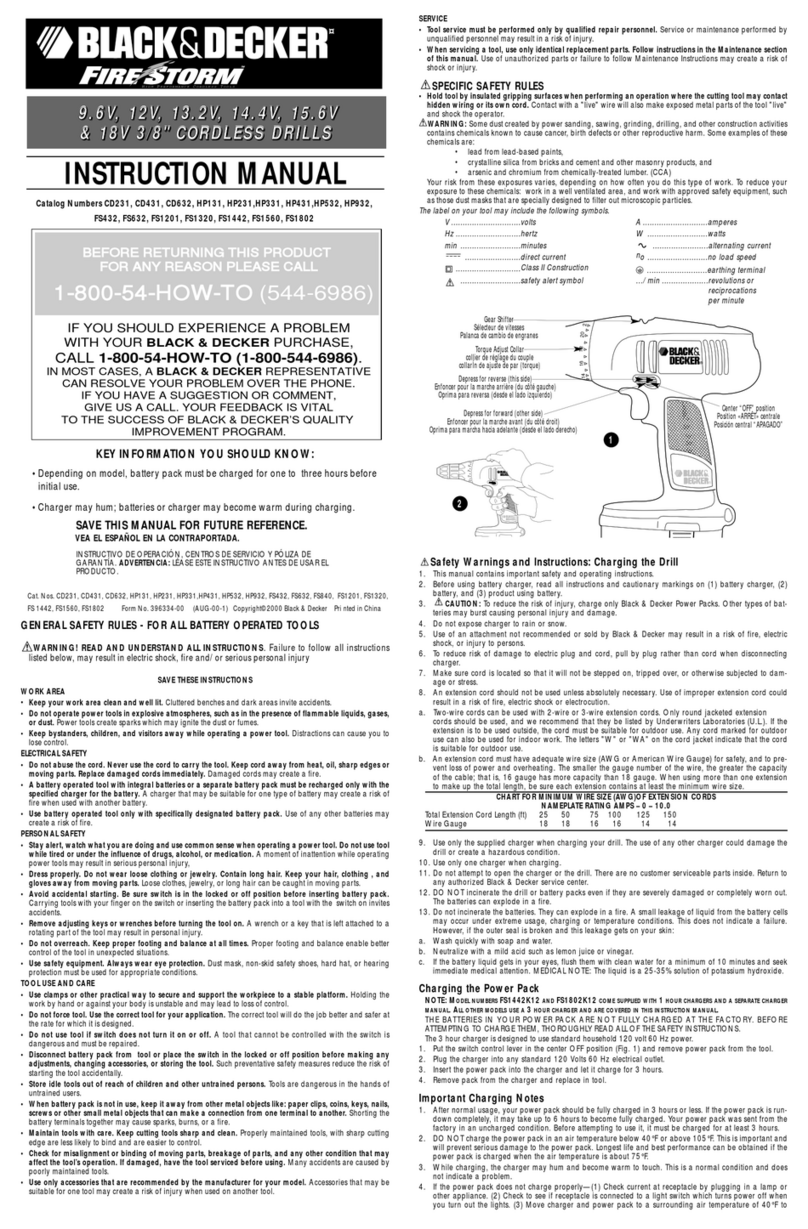
Black & Decker
Black & Decker Fire Storm CD632 instruction manual
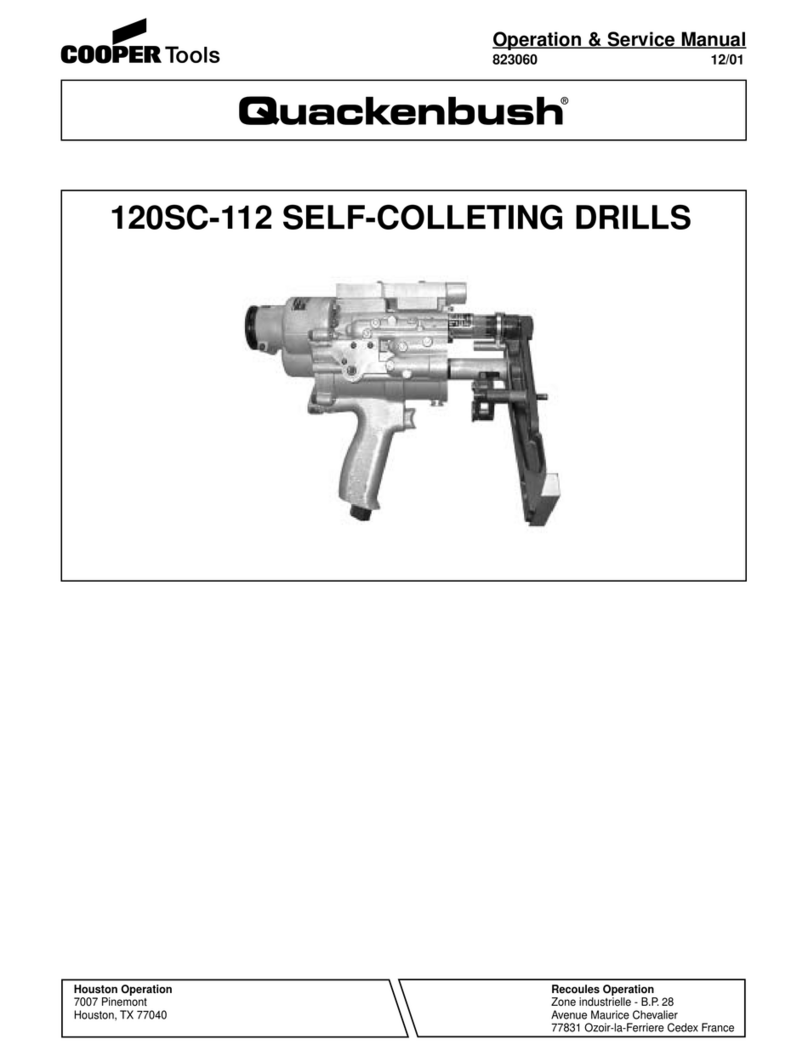
Cooper Tools
Cooper Tools Quackenbush 120SC-112 Operation & service manual

Hitachi
Hitachi DC 120VA Handling instructions

DeWalt
DeWalt DCD791B instruction manual
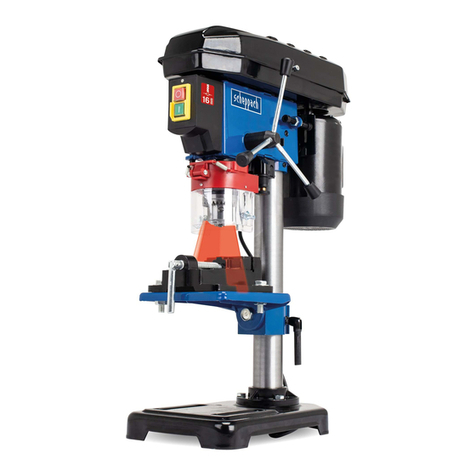
Scheppach
Scheppach DP16VLS instruction manual


